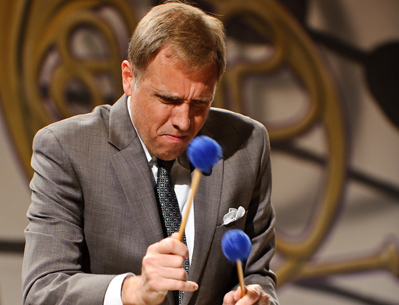Dec 9, 2025 12:28 PM
In Memoriam: Gordon Goodwin, 1954–2025
Gordon Goodwin, an award-winning saxophonist, pianist, bandleader, composer and arranger, died Dec. 8 in Los Angeles.…

The organic nature of Helfer’s artistry is genuine, developed over a lifetime of apprenticeship, appreciation and practice.
(Photo: Marc Pokempner)Blues, boogie, jazz and American roots pianist Erwin Helfer is the unlikely-but-grateful poster boy for survival of the COVID-19 pandemic. Having been hospitalized in spring 2020 for a severe depression brought on by enforced isolation, he was saved by electroconvulsive therapy — also known as shock treatment.
In January 2022, he celebrated his 86th birthday at Chicago’s Old Town School of Folk Music, following the release of a new album, Celebrate The Journey, and an instructional book, Blues Piano and How to Play It.
“There were three reasons I fell into that dark hole,” Helfer explained in a phone interview. “First off, I couldn’t play.” Before music venues were shuttered against the disease, Helfer had been gigging weekly, solo and with a band. “Secondly, I couldn’t teach,” he said. Helfer has long given children and adults lessons in the living room of his home on a street which the city has designated Erwin Helfer Way. “Third, I couldn’t access my finances,” he lamented.
Although fiscally secure, Helfer, like many octogenarians, was not adept at online banking, typically riding his bicycle to the local branch to do business. At home alone, without that access, he slipped into unfounded fears that whipped into a whirlpool of delusion and pessimism. Friends got him admitted to Rush Memorial Hospital, where he spent six weeks and underwent multiple electroshock sessions.
After getting home, Helfer declined to play, feeling he’d lost motivation, not to mention his chops. But the music that he has immersed himself in since high school in the early 1950s drew him back in. When a local television newscaster had arranged for a piano to be in the studio where he interviewed Helfer for a piece on his rich life, the pianist wandered over to it, sat down and played a song. The feeling was still there. As opportunities gradually opened to play live again in 2021, he resumed both teaching and performing.
Onstage, Helfer is an outgoing and original entertainer. He revisits classic repertoire such as Jelly Roll Morton’s “Sweet Substitute” and Avery Parrish’s “After Hours.” He re-energizes standards like “Swanee River” with an upbeat treatment or digs into showpieces including “Pinetop’s Boogie.” And he sprinkles in corny jokes as well as his own compositions such as “Daydreaming,” which imbue blues forms with influences he’s absorbed from Johann Sebastian Bach, Bela Bartók and Thelonious Monk as well as Jimmy Yancey and Otis Spann. In his hands, the disparate threads flow naturally. The organic nature of his artistry is genuine, developed over a lifetime of apprenticeship, appreciation and practice.
Born into a family that enjoyed weekend musical parties, Helfer in his teens became a protégé of Bill Russell — a co-author of Jazzmen, the first American book on New Orleans’ early players as well as an avant-garde classical composer, record store owner, record producer, violinist and collector of ephemera that was eventually published in the encyclopedia scrapbook Oh, Mr. Jelly. Through Russell, Helfer met players who’d been at jazz’s birth, like the drummer Baby Dodds.
Enrolling in Tulane University in New Orleans (where Russell had relocated), Helfer became friends with early jazz artists such as trumpeter De De Pierce and his pianist-singer wife, Wilhelmina Madson Goodson, better known for her stage name, Billie Pierce. In 1957, he featured her along with Doug Suggs, James “The Bat” Robinson and re-discovered St. Louis-based boogie master Speckled Red on Primitive Piano, produced on his own Tone Records. It was the first of several projects Helfer initiated, convening blues and boogie players like Blind John Davis, Willie Mabon, Sunnyland Slim and Jimmy Walker for Heavy Timbre or Barrelhouse Chuck, Detroit Junior and Pinetop Perkins for 8 Hands On 88 Keys.
Helfer received a bachelor’s degree from the American Conservatory of Music and a master’s degree from Northeastern Illinois University. He made his professional debut while still in high school, substituting for Little Brother Montgomery as accompanist for Mama Estelle Yancy, the widow of famed pianist Jimmy Yancy. Their collaboration inspired one of his signature compositions, “Stella,” and continued until her death at age 90 in 1986.
But Helfer had long since expanded his blues activities. During the ’60s, he gave piano lessons to harmonica-playing bandleader Paul Butterfield, recorded the single “Drunken Boat”/“Whole Lotta Soul” (written by Nick Gravenites), took avant-garde breaks by AACM trumpeter Lester Bowie and saxophonist Roscoe Mitchell, and tried out the new technology of keyboard synthesisis on Chess Records’ Moogie Woogie, (which he deplores). He also dipped into the Great American Songbook for his first solo album, On The Sunny Side Of The Street, with soprano saxophonist Clark Dean, drummers S.P. Leary and Odie Payne, and bassists Truck Parnham, Eddie Calhoun and Betty Dupree.
Helfer’s discography continues to grow, with seven albums since 2002 on the Sirens label documenting his solos, trios and larger ensembles tackling compositions by Duke Ellington, Ray Charles and Fats Waller, among others. His Blues Piano and How To Play It is a comprehensive instructional volume for players of all levels, detailing basics and nuances, all underwritten by his dictum that “the best way to learn to play blues and jazz is by ‘hanging out’ with the people who play it and listening obsessively to recordings of the music.”
Such was the pianist’s blues-boogie-jazz-roots education, which he has enabled newcomers to similarly pursue when he’s at the piano bench at home, teaching at the annual Augusta Heritage Center blues camp in Elkins, West Virginia, on tour in Europe and at parties and benefits for progressive causes in Chicago.
The extreme depression he suffered and the unusual health care that healed him seem to have left no lasting ill effects. A sweet-tempered and modest man, he’s booking appearances into the future. His blues express the range of emotions from sadness to joy. He summarizes his experiences simply. “I feel real lucky,” he said. Listeners share that luck when they tune into Erwin Helfer’s music. DB

Goodwin was one of the most acclaimed, successful and influential jazz musicians of his generation.
Dec 9, 2025 12:28 PM
Gordon Goodwin, an award-winning saxophonist, pianist, bandleader, composer and arranger, died Dec. 8 in Los Angeles.…

Belá Fleck during an interview with Fredrika Whitfield on CNN.
Jan 13, 2026 2:09 PM
The fallout from the renaming of the John F. Kennedy Center for the Performing Arts to include President Donald…

Flea has returned to his first instrument — the trumpet — and assembled a dream band of jazz musicians to record a new album.
Dec 2, 2025 2:01 AM
After a nearly five-decade career as one of his generation’s defining rock bassists, Flea has returned to his first…

Dec 11, 2025 11:00 AM
DownBeat presents a complete list of the 4-, 4½- and 5-star albums from 2025 in one convenient package. It’s a great…

Vibraphonist Chuck Redd found himself in the midst of a political firestorm after canceling his gig Dec. 24 at the newly renamed Trump Kennedy Center.
Jan 6, 2026 2:32 AM
The Board of Trustees at Washington, D.C.’s Kennedy Center for the Performing Arts voted on Dec. 18 to rename the…